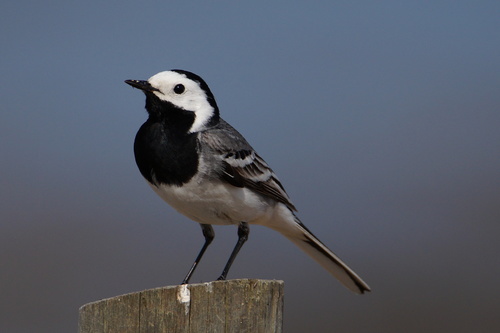
White Wagtail
The White Wagtail (Motacilla alba) is a slender, striking bird known for its characteristic tail-wagging behavior. This small passerine bird is widespread across Europe, Asia, and parts of North Africa, and has even established a foothold in Alaska. It plays a vital role in controlling insect populations, and its adaptability has allowed it to thrive in a range of habitats, from open countryside to urban environments. The White Wagtail is often featured in folklore and is considered a harbinger of spring in some cultures.
16.5-19 cm
Length
25-30 cm
Wingspan
Least Concern
Conservation Status
Distribution
Widespread across Europe, Asia, and parts of North Africa. Also breeds in Alaska. Migratory populations winter in Africa, southern Asia, and the Middle East. Altitudinal range varies from sea level to high-altitude meadows and plateaus.
Lifespan
Typically 3-5 years in the wild, but can live longer in captivity.
White Wagtail's Habitat
Habitat Types
Open countryside, Farmland, Wetlands, Riverbanks, Urban areas, Coastal regions
Climate Zones
Temperate, Boreal, Mediterranean, Subtropical
Adaptations
White Wagtails are highly adaptable and can tolerate a wide range of environmental conditions. Their long legs and claws are well-suited for walking and running on various surfaces, including uneven ground and vegetation.
Variations
There are several recognized subspecies of White Wagtail (e.g., *Motacilla alba alba*, *Motacilla alba yarrellii* (Pied Wagtail)), which differ primarily in plumage patterns, particularly on the head and back. These variations are often linked to specific geographic regions.
Appearance
Breeding Plumage
Breeding males typically have a sharper contrast between black and white plumage, with a more defined black cap and breast band. Non-breeding plumage is often duller, with grey replacing some of the black.
Seasonal Feather Changes
See above. Plumage becomes duller after breeding season.
Sex Based Plumage Differences
Males generally have more intense black markings, especially during the breeding season. Females and juveniles tend to have greyer tones.
Notable Features
Constantly wagging tail, Striking black and white plumage, Slender body shape, Long legs
Diet and Feeding
Primary Foods
Insects, Spiders, Small invertebrates, Occasionally seeds
Foraging Behavior
White Wagtails are primarily ground feeders. They run and peck at prey, often near water or in open areas with short vegetation. They also hawk insects in flight, performing short aerial sallies.
Specializations
Their agility and quick movements are key to capturing fast-moving insects. Their long legs allow them to wade in shallow water to catch aquatic invertebrates.
Seasonal Diet Variations
Diet may shift slightly depending on insect availability. During periods of insect scarcity, they may consume more seeds or small berries.
Behavior
Social Structure
Generally found in pairs or small family groups during the breeding season. Outside of breeding, they may form larger flocks, especially during migration and at roosting sites.
Communication
Sharp 'chiz-ik' calls, Soft twittering songs, Tail-wagging (used for communication, possibly to flush out insects)
Migration
Many populations are migratory, traveling long distances between breeding and wintering grounds. Migration is often nocturnal.
Territorial or Group Behaviors
Territorial during the breeding season, defending nesting sites and feeding areas. Outside of breeding, they are more gregarious and may form communal roosts.
Conservation
Threats
Habitat loss (due to urbanization and agricultural intensification), Pesticide use (reducing insect prey), Climate change (affecting migration patterns and breeding success)
Protection Programs
General wildlife protection laws in many countries, Habitat restoration projects
Local National Laws
Protected under various national and international wildlife laws, including the Migratory Bird Treaty Act in the United States (for Alaskan populations).
Population Trend
Stable
Population Estimates
Global population estimated to be between 130,000,000 and 230,000,000 individuals.
Interesting Facts
The White Wagtail's constant tail-wagging is a distinctive characteristic.
The exact reason for this behavior is still debated, but it may help flush out insects or serve as a social signal.
They are known to use human-made structures for nesting.
This adaptability has allowed them to thrive in urban environments.
The Pied Wagtail (*Motacilla alba yarrellii*) is a subspecies found in Britain and Ireland.
It has more extensive black plumage than the nominate subspecies.
Faqs about White Wagtail
Why do White Wagtails wag their tails?
The precise reason is unknown, but it may be related to foraging (flushing out insects) or communication.
Are White Wagtails migratory?
Many populations are migratory, undertaking long-distance journeys between breeding and wintering areas.
What do White Wagtails eat?
Primarily insects, spiders, and other small invertebrates. They occasionally eat seeds.
Where do White Wagtails nest?
They build cup-shaped nests in a variety of locations, including crevices, holes in walls, and dense vegetation.
Copyright @ Nature Style Limited. All Rights Reserved.
 English
English